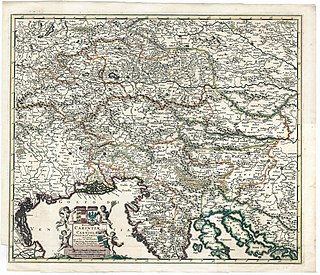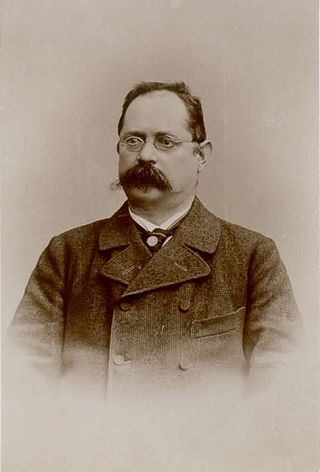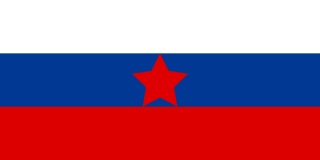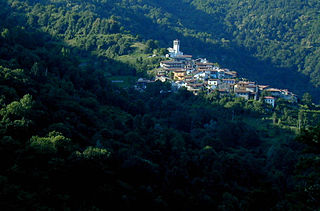
Slovenia, officially the Republic of Slovenia, is a country in southern Central Europe. Slovenia is bordered by Italy to the west, Austria to the north, Hungary to the northeast, Croatia to the south and southeast, and a short coastline within the Adriatic Sea to the southwest. Slovenia is mostly mountainous and forested, covers 20,271 square kilometres (7,827 sq mi), and has a population of approximately 2.1 million. Slovene, a South Slavic language, is the official language. Slovenia has a predominantly temperate continental climate, with the exception of the Slovene Littoral and the Julian Alps. A sub-mediterranean climate reaches to the northern extensions of the Dinaric Alps that traverse the country in a northwest–southeast direction. The Julian Alps in the northwest have an alpine climate. Toward the northeastern Pannonian Basin, a continental climate is more pronounced. Ljubljana, the capital and largest city of Slovenia, is geographically situated near the centre of the country.

The history of Slovenia chronicles the period of the Slovenian territory from the 5th century BC to the present. In the Early Bronze Age, Proto-Illyrian tribes settled an area stretching from present-day Albania to the city of Trieste. The Slovenian territory was part of the Roman Empire, and it was devastated by the Migration Period's incursions during late Antiquity and the Early Middle Ages. The main route from the Pannonian plain to Italy ran through present-day Slovenia. Alpine Slavs, ancestors of modern-day Slovenians, settled the area in the late 6th Century AD. The Holy Roman Empire controlled the land for nearly 1,000 years, and between the mid-14th century and 1918 most of Slovenia was under Habsburg rule. In 1918, most Slovene territory became part of the Kingdom of Serbs, Croats, and Slovenes, and in 1929 the Drava Banovina was created within the Kingdom of Yugoslavia with its capital in Ljubljana, corresponding to Slovenian-majority territories within the state. The Socialist Republic of Slovenia was created in 1945 as part of federal Yugoslavia. Slovenia gained its independence from Yugoslavia in June 1991, and today it is a member of the European Union and NATO.

The Slovenes, also known as Slovenians, are a South Slavic ethnic group native to Slovenia, and adjacent regions in Italy, Austria and Hungary. Slovenes share a common ancestry, culture, history and speak Slovene as their native language. According to ethnic classification based on language, they are closely related to other South Slavic ethnic groups, as well as more distantly to West Slavs.

Styria, also known as Slovenian Styria or Lower Styria to differentiate it from Austrian Styria, is a traditional region in northeastern Slovenia, comprising the southern third of the former Duchy of Styria. The population of Styria in its historical boundaries amounts to around 705,000 inhabitants, or 34.5% of the population of Slovenia. The largest city is Maribor.
Scoutingin Slovenia is served by three associations:

The Slovene Littoral, or simply Littoral, is one of the traditional regions of Slovenia. The littoral in its name – for a coastal-adjacent area – recalls the former Austrian Littoral, the Habsburg possessions on the upper Adriatic coast, of which the Slovene Littoral was part. Today, the Littoral is often associated with the Slovenian ethnic territory that, in the first half of the 20th century, found itself in Italy to the west of the Rapallo Border, which separated a quarter of Slovenes from the rest of the nation, and was strongly influenced by Italian fascism.

The Slovene lands or Slovenian lands is the historical denomination for the territories in Central and Southern Europe where people primarily spoke Slovene. The Slovene lands were part of the Illyrian provinces, the Austrian Empire and Austria-Hungary. They encompassed Carniola, southern part of Carinthia, southern part of Styria, Istria, Gorizia and Gradisca, Trieste, and Prekmurje. Their territory more or less corresponds to modern Slovenia and the adjacent territories in Italy, Austria, Hungary, and Croatia, where autochthonous Slovene minorities live. In the areas where present-day Slovenia borders to neighboring countries, they were never homogeneously ethnically Slovene.

The Province of Ljubljana was the central-southern area of Slovenia. In 1941, it was annexed by the Kingdom of Italy, and after 1943 occupied by Nazi Germany. Created on May 3, 1941, it was abolished on May 9, 1945, when the Slovene Partisans and partisans from other parts of Yugoslavia liberated it from the Nazi Operational Zone of the Adriatic Littoral. Its administrative centre was Ljubljana.

Ivan Hribar was a Slovene and Yugoslav banker, politician, diplomat and journalist. During the start of the 20th century, he was one of the leaders of the National Progressive Party, and one of the most important figures of Slovene liberal nationalism. Between 1896 and 1910, he was the mayor of Ljubljana, and greatly contributed to its rebuilding and modernisation after the 1895 earthquake.

Simon Rutar was a Slovene historian and geographer. He wrote primarily on the history and geography of the areas that are now part of the Slovenian Littoral, the Italian region of Friuli-Venezia Giulia and the Croatian counties of Istria and Primorsko-Goranska.

Lavo Čermelj, Italianized name Lavo Cermeli, was a Slovene physicist, political activist, journalist, and author. In the 1930s, he was one of the foremost representatives of Slovene anti-Fascist émigrés from the Italian-administered Julian March, together with Josip Vilfan, Ivan Marija Čok, and Engelbert Besednjak.

Bogumil Vošnjak, also known as Bogomil Vošnjak, was a Slovene and Yugoslav jurist, politician, diplomat, author, and legal historian. He often wrote under the pseudonym Illyricus.

Peter Vodopivec is a Slovenian historian and public intellectual.

Jože Pirjevec, registered at birth Giuseppe Pierazzi because of the Italianization policy under the Fascist regime, is a Slovene–Italian historian and a prominent diplomatic historian of the west Balkans region, as well as a member of the Slovenian Academy of Sciences and Arts.

Milko Brezigar was a Slovene and Yugoslav liberal economist.

Engelbert Besednjak was a Slovene Christian Democrat politician, lawyer and journalist. In the 1920s, he was one of the leaders of the Slovene and Croat minority in the Italian-administered Julian March. In the 1930s, he was one of the leaders of Slovene anti-Fascist émigrés from the Slovenian Littoral, together with Josip Vilfan, Ivan Marija Čok and Lavo Čermelj.

Josip Vilfan or Wilfan was a Slovene lawyer, politician, and human rights activist from Trieste. In the early 1920s, he was one of the political leaders of the Slovene and Croatian minority in the Italian-administered Julian March. Together with Engelbert Besednjak, Lavo Čermelj and Ivan Marija Čok, he was the most influential representative of the Slovene émigrés from the Slovenian Littoral during the 1930s. Next to Leonid Pitamic and Boris Furlan, Vilfan is considered one of the most important Slovene legal theorists of the first half of the 20th century.

The Slovene Partisans, formally the National Liberation Army and Partisan Detachments of Slovenia, were part of Europe's most effective anti-Nazi resistance movement led by Yugoslav revolutionary communists during World War II, the Yugoslav Partisans. Since a quarter of Slovene ethnic territory and approximately 327,000 out of total population of 1.3 million Slovenes were subjected to forced Italianization since the end of the First World War, the objective of the movement was the establishment of the state of Slovenes that would include the majority of Slovenes within a socialist Yugoslav federation in the postwar period.
Slovene minority in Italy, also known as Slovenes in Italy is the name given to Italian citizens who belong to the autochthonous Slovene ethnic and linguistic minority living in the Italian autonomous region of Friuli-Venezia Giulia. The vast majority of members of the Slovene ethnic minority live in the Provinces of Trieste, Gorizia, and Udine. Estimates of their number vary significantly; the official figures show 52,194 Slovenian speakers in Friuli-Venezia Giulia, as per the 1971 census, but Slovenian estimates speak of 83,000 to 100,000 people.

Slavia Friulana, which means Friulian Slavia, is a small mountainous region in northeastern Italy and it is so called because of its Slavic population which settled here in the 8th century AD. The territory is located in the Italian region of Friuli-Venezia Giulia, between the town of Cividale del Friuli and the Slovenian border.


















